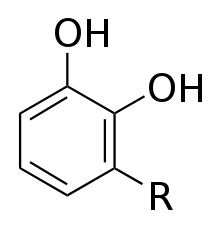Urushiol
 R = (CH2)14CH3 or R = (CH2)7CH=CH(CH2)5CH3 or R = (CH2)7CH=CHCH2CH=CH(CH2)2CH3 or R = (CH2)7CH=CHCH2CH=CHCH=CHCH3 or R = (CH2)7CH=CHCH2CH=CHCH2CH=CH2 and others |
Urushiol /ʊˈruːʃi.ɒl/ is an oily organic allergen found in plants of the family Anacardiaceae, especially Toxicodendron spp. (e.g., poison oak, Lacquer Tree, poison ivy, poison sumac) and also in mangos.[1][2][3][4][5] In sensitive individuals, urushiol can cause an allergic skin rash on contact,[6] known as urushiol-induced contact dermatitis. The name comes from the Japanese word for the tree Toxicodendron vernicifluum (漆 urushi).[7]
The oxidation and polymerization of urushiol in the tree's sap in the presence of moisture allows it to form a hard lacquer, which is used to produce traditional Chinese, Korean and Japanese lacquerware.
Characteristics
Urushiol is a pale-yellow liquid with specific gravity of 0.968 and a boiling point of 200 °C (392 °F). It is soluble in alcohol, ether, and benzene.[8] Urushiol is a mixture of several closely related organic compounds. Each consists of a catechol substituted with an alkyl chain that has 15 or 17 carbon atoms. The alkyl group may be saturated or unsaturated. The exact composition of the mixture varies depending on the plant source. Whereas western poison oak urushiol contains chiefly catechols with C17 side-chains,[9] poison ivy and poison sumac contain mostly catechols with C15 side-chains. The likelihood and severity of allergic reaction to urushiol is dependent on the degree of unsaturation of the alkyl chain. Less than half of the general population reacts with the saturated urushiol alone, but over 90% react with urushiol containing at least two degrees of unsaturation (double bonds). Longer side chains tend to produce stronger reaction.[10] This suggests that the allergic contact dermatitis is caused by Van der Waals forces.[10]
Before urushiol has been absorbed by the skin it can be removed with soap and water. However, time is of great importance as 50% of urushiol can be absorbed within 10 minutes. Once urushiol has penetrated into the skin, attempting to remove with water is inefficient.[10] Once urushiol has been absorbed by the skin it is recognized by the immune system's dendritic cells called langerhans cells. These cells then migrate to lymph nodes where they present the urushiol to T-lymphocytes and thus recruit them to the skin. Once in the skin, the T-lymphocytes cause pathology by producing cytokines and cytotoxic damage to the skin.[11]
Urushiol is an oleoresin contained within the sap of poison ivy and related plants, and after injury to the plant or during late fall, the sap leaks to the surface of the plant where the urushiol becomes a blackish lacquer after contact with oxygen at a certain temperature and humidity.[10][12][13]
Mechanism of action
Dermatitis is mediated by an induced immune response. Urushiol acts as a hapten, leading to a Type IV hypersensitive reaction.[14]
See also
- Anti-itch drugs, for treating the toxin.
- Bentoquatam, a barrier creme applied before exposure.
- Hapten, the name of a wider class of allergens including urushiol.
- Ginkgo biloba and cashew, plants containing chemicals closely related to urushiol.
- Mango trees, which may cause cross reaction allergies with urushiol.
- Burow's Solution which can treat the symptoms of the rash caused by urushiol.
References
- ↑ Julius M. Cruse, MD; Robert E. Lewis (2010). Atlas of Immunology, Second Edition. CRC Preess. pp. 464–. ISBN 978-0849394898. Retrieved June 2014.
- ↑ "Can Reaction to Poison Ivy Cause Mango Allergy?". American College of Allergy, Asthma, and Immunology. Retrieved June 2014.
- ↑ "Urushiol: Human Health Effects". NIH. Retrieved June 2014.
- ↑ Alexander A. Fisher (2007). Fisher's Contact Dermatitis. Pmph Usa. pp. 862–. ISBN 978-0849394898. Retrieved June 2014.
- ↑ Appleby, Maia (Aug 2013). "Mango & Skin Rashes". Livestrong. Retrieved June 2014.
- ↑ Buck Tilton (2004) Wilderness First Responder: How to Recognize, Treat, and Prevent Emergencies in the Backcountry, Globe Pequot, 320 pages ISBN 0-7627-2801-9
- ↑ Oxford English Dictionary
- ↑ Hawley's Condensed Chemical Dictionary, 14th Edition, 2002, John Wiley & Sons, Inc.
- ↑ C. Michael Hogan (2008) Western poison-oak: Toxicodendron diversilobum, GlobalTwitcher, ed. Nicklas Stromberg
- ↑ 10.0 10.1 10.2 10.3 McGovern Tomas, Barkley Theodore (1998) "Review Botanical Dermatology", International Journal of Dermatology, vol 37, pp 321-334
- ↑ Gober D. Michael et al. (2008) "Human Natural Killer T Cells infiltrate into the Skin at Elicitation Sites of Allergic Contact Dermatitis" Journal of investigative Dermatology, vol 128, pp1460-1469
- ↑ Robert L. Rietschel; Joseph F. Fowler; Alexander A. Fisher (2008). Fisher's contact dermatitis. PMPH-USA. pp. 408–. ISBN 978-1-55009-378-0. Retrieved 26 July 2010.
- ↑ Donald G. Barceloux (2008). Medical Toxicology of Natural Substances: Foods, Fungi, Medicinal Herbs, Plants, and Venomous Animals. John Wiley and Sons. pp. 681–. ISBN 978-0-471-72761-3. Retrieved 26 July 2010.
- ↑ "Forget “Polytetrafluoroethene”, Pentadecacatechol is where it’s at". 11 Jul 2012. Retrieved 22 Sep 2014.
External links
- Poison Oak at Wayne's Word
- The Poison Ivy Tutorial
- NIH Toxnet